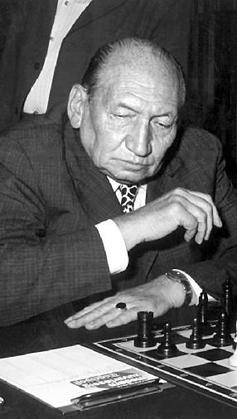Erich Eliskases facts for kids
Quick facts for kids Erich Eliskases |
|
|---|---|
 |
|
| Full name | Erich Gottlieb Eliskases |
| Country | Austria → Germany Argentina |
| Born | 15 February 1913 Innsbruck, Austro-Hungarian Empire |
| Died | 2 February 1997 (aged 83) Córdoba, Argentina |
| Title | Grandmaster (1952) |
| Peak rating | 2430 (January 1977) |
Erich Gottlieb Eliskases (born February 15, 1913 – died February 2, 1997) was a very talented chess player. He played for three different countries during his career: Austria, Germany, and Argentina. In the late 1930s, many people thought he might even become a World Chess Champion. In 1952, he earned the special title of Grandmaster from FIDE, the world chess organization.
Contents
Erich's Chess Journey
Erich was born in Innsbruck, which was part of the Austro-Hungarian Empire at the time. He started learning chess when he was twelve years old. He was very good at it right away! In his first year at a chess club, when he was just fourteen, he won the club championship.
When he was fifteen, he became the champion of Tyrol, a region in Austria. At sixteen, he was a co-winner of the Austrian Championship.
Early Successes and Wins
Erich studied business in college, but chess was his true passion. He played for Austria in big international team competitions called Olympiads in 1930, 1933, and 1935. He did incredibly well!
After Austria joined Germany in 1938, he won the German national championship in both 1938 and 1939. He also won or shared first place in other important tournaments, like in Budapest (1934), Linz (1934), Zürich (1935), and Milan (1937). He also won matches against famous players like Rudolf Spielmann.
In 1937, Erich even helped Alexander Alekhine, who was a World Champion, prepare for his rematch against Max Euwe. This shows how respected Erich was in the chess world.
His Best Years in Chess
Erich's best years were 1938 and 1939. In June 1938, he won a tournament in Noordwijk, beating strong players like Paul Keres and former world champion Max Euwe. This win was one of the best results of his career!
After that, he had an amazing streak: he played in eight tournaments in a row without losing a single game. Six of these were in 1938 and 1939, including tournaments in Krefeld, Bad Harzburg, Bad Elster, and Vienna. He also won a match against Efim Bogoljubov, another top player.
Because of his great success, people started talking about Erich playing a World Championship match against Alekhine. Records later showed that a match was planned for 1941, but it never happened.
Moving to South America
In 1939, Erich traveled to South America. He played for Germany at the 1939 Buenos Aires Olympiad. While he was there, World War II began. Many players, including Erich, decided to stay in Argentina (and for a while in Brazil) instead of going back to Europe.
Life was tough for him there, and he struggled to make a living. In Brazil, he was even threatened with being sent away. But some kind chess fans helped him by hiring him as a chess teacher, which allowed him to stay.
In 1951, he returned to Argentina and later became an Argentine citizen. He then played for Argentina in the Olympiads of 1952, 1958, 1960, and 1964. This means he played for three different countries in the Olympiads: Austria, Germany, and Argentina! He might be the only chess player ever to do that.
He continued to win tournaments in South America, including in Águas de São Pedro/São Paulo (1941), São Paulo (1947), Mar del Plata (1948), Punta del Este (1951), and Córdoba (1959).
Later Years and Legacy
Erich was given the title of International Master in 1950 and Grandmaster in 1952. He kept playing chess through the 1950s, 1960s, and even into the 1970s.
In 1954, he married María Esther Almeda from Argentina, and they had a son named Carlos Enrico. In 1976, Erich and his wife tried moving back to Austria, but they didn't settle well and returned to Córdoba, Argentina.
Erich was also a very strong correspondence chess player, which means he played games by sending moves through mail. He won over 75% of his games during his most active period!
He was known for being an expert in the endgame, which is the final part of a chess game. At a tournament in Semmering in 1937, he even beat José Raúl Capablanca, a former world champion who was famous for his endgame skills. Chess expert Hans Ree noted that Erich Eliskases is one of only four players who managed to beat both Capablanca and Bobby Fischer, another legendary world champion. Erich had equal scores in his games against Euwe (3 wins, 3 losses), Capablanca (2 wins, 2 losses), and Fischer (1 win, 1 loss).
Notable Games: Erich's Big Wins
Here are some of Erich Eliskases' most famous games where he beat chess legends:
- Against Max Euwe (1935): This was Erich's first win against Euwe, who became world champion that same year.
- Against José Raúl Capablanca (Semmering 1937): Erich showed his amazing endgame skills by defeating Capablanca, who was a master of the endgame.
- Against Bobby Fischer (Buenos Aires 1960): Erich also managed to beat the future world champion, Bobby Fischer, in a tough game.
See also
 In Spanish: Erich Eliskases para niños
In Spanish: Erich Eliskases para niños

